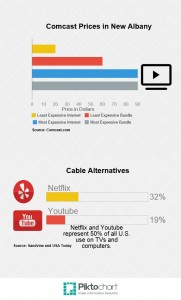Cutting the cable cord and finding alternatives to cable have become a trend on the IU Southeast campus.Over 900,000 households in America have cut the cable cord in the last year, according to Craig Moffett, an analyst who covers the sector.
On average, households pay $90 a month for cable television service according to NPD Group.
Cord cutters believe that the cost of television is too high and that cable consumers are not watching most of what they are paying for.
According to New York Times, over the past couple of years, millions of Americans have ditched cable in favor of online streaming services such as Netflix and Youtube.
James Kauffman, professor of communication studies, got rid of his cable service over two years ago. Many students are likely doing the same.
“The content college students are accessing is entertainment and information 24/7 and from anywhere,” said Kauffman.
Kauffman said that some of his students use Roku to share media with others. With an internet connection you can stream various magazines, newspapers and YouTube videos through Roku.
According to USA Today, Netflix and YouTube represent 50 percent of all United States traffic on televisions and computers.
Kauffman said there is an economic impact for the producer of the shows because the viewer is not buying the DVD or viewing commercials.
Netflix has agreed to a deal with Comcast that will provide Comcast customers “a high-quality Netflix video experience for years to come”.
Haley Warwick, journalism junior, said, “I do not pay for cable because it is too expensive. I watch Netflix. A lot of people find that the entry price for cable goes up and then they reconsider. My friend switched to AT&T U-verse because of the high prices.”
The real question is, are cord cutters truly escaping the cord and are they really saving money?
With the trend of cord cutting, the consumer generally makes their choice in a certain way. “The consumer will make a choice that will maximize benefits and minimize price,” said Kathleen Arano, assistant professor of economics.
According to New York Times, the cable giants will simply become even more inescapable internet giants.
Kauffman said that Richard Rodriguez, a producer in Texas, is producing his own television station. Rodriguez’s action may play a role in finding another alternative to the cable giants. The shows deliver the product and he produces the show. The shows can be found on Telemundo, and it mainly has hispanic shows.
“There might be international cable companies someday. The world competition in cable companies would probably result in better prices and customer service. It could also encourage international education with the different languages involved in the shows,” said Kauffman.
Arano mentioned that when there is not as much competition with technology there will be less barriers therefore resulting in a larger fixed cost.
Arano said that cable service has gone from “a la carte service” to bundle service and now will just be a speak and choose service.
By finding alternatives to cable, it gives the power to Comcast and Time Warner to raise prices for broadband and cable television service.
“In order for you to get content you like, you are going to be pushed to pay the cable bill, too,” Craig Aaron, President of Free Press, said.
Comcast’s current rates for service are quite similar to each other. Basic internet service is $40 with 25 mbps. Their television and internet package is $50.Cutting the cord as a customer of Comcast does not save you much money.
“A customizable cable package would be more reasonable in price and you would get channels you are interested in,” said Kauffman.
“Cord cutting illustrates the changes in the industry and the need to adjust to changes in technology and competition to keep customers happy,” said Arano.
To learn more about alternatives to cable visit
www.forbes.com/sites/amadoudiallo/2013/10/16/how-to-cut-the-cord-cable-tv/








